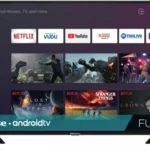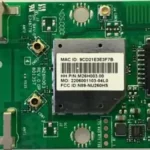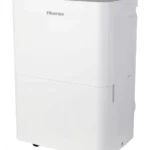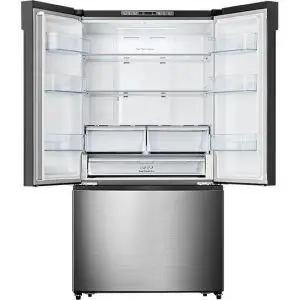
User Manual

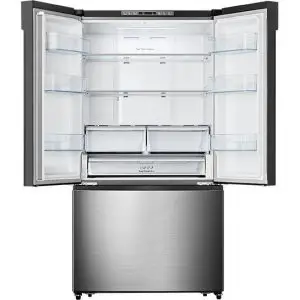
Hisense RF208N6CSE French Door Refrigerator
Before operating this unit, please read this manual thoroughly, and retain for future reference.
Brief Introduction
Thank you for your choosing Hisense. We are sure you will find your new refrigerator a pleasure to use. Before you use the appliance, we recommend that you read through these instructions carefully, which provides details about its usage and functions.
- Please ensure that everyone using this appliance is familiar with its operations and safety features. It is important that you install the appliance correctly and pay careful attention to the safety instructions.
- we recommend that you keep this user’s manual with the appliance for future reference.
- This appliance is intended to be used in households and similar applications such as:
-Staff kitchen-areas in shops, offices and other working environments;
-Clients in hotels, motels and other residential types of environment;
-Bed and breakfast type of environments;
-Catering and similar non-retail applications.
- This appliance is not intended for use by persons (including children) with reduced
physical, sensory or mental capabilities, or lack of experience and knowledge, unless
they have supervision or been given instruction concerning use of the appliance. Children should be supervised to ensure that they do not play with the appliance.
- Do not store explosive substances such as aerosol cans with a flammable propellant in this appliance.
WARNING – Connect to potable water supply only.
WARNING – Do not use mechanical devices or other means to accelerate the defrosting process, other than those recommended by the manufacturer.
WARNING – Do not damage the refrigerant circuit
WARNING – Do not use electrical appliances inside the food storage compartments of the appliance, unless they are of the type recommended by the manufacturer
WARNING – When disposing of the appliance do so only at an authorized waste disposal center. Do not expose to flame.
WARNING– The instructions include the following wording regarding the use of extension cords: Do not use an extension cord.
WARNING-If the supply cord is damaged, it must be replaced by the manufacturer, its service agent or similarly qualified persons in order to avoid a hazard.
WARNING-Keep ventilation openings, in the appliance enclosure or in the built-in structure, clear of obstruction.
Important Safety Instructions
General safety and daily use
 It is important to use your safely. appliance we recommend that you follow the guidelines below.
It is important to use your safely. appliance we recommend that you follow the guidelines below.
- Store any food in accordance with the from the storage instructions manufacturer.
- Don’t try to repair the appliance yourself. It is dangerous to alter the specifications or modify this product in any way. Any damage to the power cord may cause a short circuit, fire or electric shock.
- Don’t place too much food directly against the air outlet on the rear wall of both the refrigerator and freezer compartment, as it affects sufficient air circulation.
- Don’t place hot items near the plastic components of this appliance.
- Frozen food must not be refrozen once it has been thawed out.
- Don’t store bottled or canned drinks (especially carbonated drinks) in the freezer compartment. Bottles and cans may explode.
- use caution consuming popsicles or ice cubes straight from the freezer as this can cause freezer burn to the mouth and lips.
Safety for children and infirm persons
- Keep all packaging away from children to avoid risk of suffocation.
- Protect children from being scalded by touching the compressor at the rear bottom of appliance
- Don’t place items on top of the appliance as this could cause injury should they fall off.
- Never allow children to play with the appliance by hanging or standing over or on the doors, racks, shelves and drawers etc.
Electrical Safety
 To avoid the risks that are always present when using an electric appliance, we recommend that you pay attention to the instructions about electricity below.
To avoid the risks that are always present when using an electric appliance, we recommend that you pay attention to the instructions about electricity below.
- Unpack and check through the appliance. Should any damage be evident, don’t plug in the appliance but contact the shop immediately from which you purchased it. Keep all packing materials in this case.
- we recommend that you wait for 4 hours before connecting the appliance to allow the refrigerant to flow back into the compressor.
- The appliance must be applied with single phase alternating current of 115V/60Hz. If the voltage fluctuates exceeding the upper limit, A.C. automatic voltage regulator of more than 350W should be applied to the refrigerator for safety use.
- The power plug must be accessible when the appliance is installed.
- This appliance must be grounded.
- This appliance is fitted with a plug, in accordance with local standard. The plug should be suitable for use in all houses fitted with sockets in accordance with current specifications.
- If the fitted plug is not suitable for your socket outlets, it should be cut off and carefully disposed of. To avoid a possible shock hazard, do not insert the discarded plug into a socket. If in doubt contact a qualified, registered electrician.
- Do not use extension cords or multiple sockets which could cause overloading of wiring circuits and could cause fire. Always plug your appliance into its own individual electrical socket which has a voltage rating that matched the rating plate.
- Make sure that the plug is not squashed or damaged. Otherwise, it may cause short circuit, electric shock or overheat and even cause a fire.
- Do not insert the power plug if the socket is loose, there is a risk of electric shock or fire.
- Never unplug the appliance by pulling on the electrical cord. Aways grip the plug firmly and pull straight out from the socket to prevent damaging the power cord.
- Do not operate the appliance without the cover of interior lighting.
- Any electrical component must be replaced or repaired by a qualified electrician or authorized service engineer. Only genuine replacement parts should be used.
- WARNING: Do not use electrical appliances such as ice cream makers inside the food storage compartments of the appliance unless they are approved by the manufacturer.
- To avoid eye injury, do not look direct into the LED light located in the refrigerator compartment. If it is not functioning correctly, consult a qualified, registered electrician or replace it in accordance with the “cleaning and care” chapter.
Refrigerant
The refrigerant isobutene (R600a) is contained within the refrigerant circuit of the appliance. During transportation and installation of the appliance, ensure that none of the components of the refrigerant circuit becomes damaged.
The refrigerant (R600a) is flammable.
Caution: Risk of Fire
![]() Don’t store products which contain flammable propellants (e.g. spray cans) or explosive substances in the appliances.
Don’t store products which contain flammable propellants (e.g. spray cans) or explosive substances in the appliances.
Should the refrigerant circuit be damaged:
- Avoid open flames (candles, lamps etc.) and sources of ignition.
- Thoroughly ventilate the room in which the appliance is situated.
- Do not use extension cords or ungrounded (two prong) adapters.
- For appliances with TYPE Y ATTACHMENT, the instructions shall contain the substance of the following.
- If the SUPPLY CORD is damaged, it must be replaced by the manufacturer, its service agent or similarly qualified person in order to avoid a hazard.
- DANGER: Risk of child entrapment. Before you throw away your old appliance: Take off the doors Leave the shelves in place so that children may not easily climb inside.
Installing Your New Appliance
Before using the appliance for the first time, you should be informed of the following tips.
Warning!
For proper installation, this refrigerator must be placed on a level surface of hard material that is the same height as the rest of the flooring. This surface should be strong enough to support a fully loaded refrigerator.
The rollers, which are not castors, should be only used for forward or backward movement. Moving the refrigerator sideways may damage your floor and the rollers.
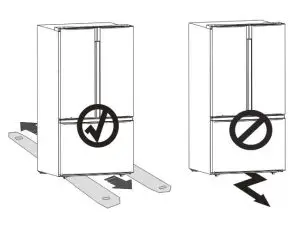
Ventilation of Appliance
 In order to improve efficiency of the cooling system and save energy, it is necessary to maintain good ventilation around the appliance for the dissipation of heat. For this reason, sufficient clear space should be available around the refrigerator.
In order to improve efficiency of the cooling system and save energy, it is necessary to maintain good ventilation around the appliance for the dissipation of heat. For this reason, sufficient clear space should be available around the refrigerator.
Suggestion: It is advisable for there to be at least 75mm (3″) of clearance from the back of the fridge to the wall, at least 100mm (4″) of clearance from its top, at least 100mm (4″) from its side to the wall and a clear space in front to allow the doors to open 125o. As shown in following diagrams.
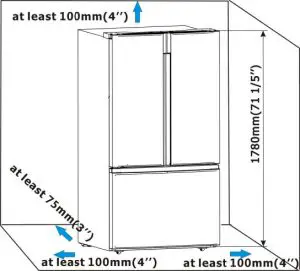
Note:
This appliance performs well within the climate class from N to T shown in the table below. It may not work properly if left at a temperature above or below the indicated range for a long period.

- Stand your appliance in a dry place to avoid high moisture.
- Keep the appliance out of direct sunlight, rain or frost. Stand the appliance away from heat sources such as stoves, fires or heaters.
Leveling of appliance
- For sufficient leveling and air circulating in the lower rear section of the appliance, the bottom feet may need to be adjusted. You can adjust them manually by hand or by using a suitable tool.
- To allow the doors to self-close, tilt the top backwards by 10 to 15mm


Door Removal
In case your home access door is too narrow for the refrigerator to pass through, remove the refrigerator doors and drawers. If you do not need to remove the appliance doors, proceed to ‘Installing Water Lines’ on page 8.If you need to remove the doors, continue below.
Tools you will need (Not provided):
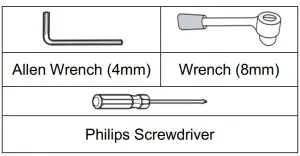
Disassembling the fridge door
Some models may be slightly different from pictures. If some parts shown in the picture cannot be found in your appliance, please ignore the relevant description.
- With the door closed, remove the 3 screws holding the top cover (A) with Philips (+) screwdriver, and then remove the top cover with the entire-harness attached.
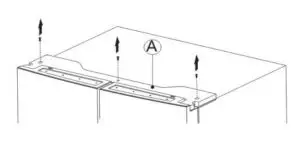
- Take out connectors and the water coupler from the installation clip. Remove the two wire connectors (press the top of the connector (B) and separate it from the other one) on the left side door. To remove the water coupler from the hinge, twist and pull the clips from the coupler then remove the water line (C) while pressing the movable part (D) of the water line coupler.
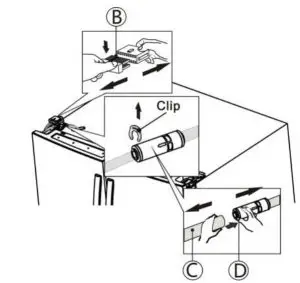
- Remove the 3 screws (B) fixed on the hinges with a wrencrenc h ( h (8mm)mm)mm) and 1 ground screws (C) attached to the hinge with Philips (+) screwdriver. Remove the upper left and right door hinges (D).
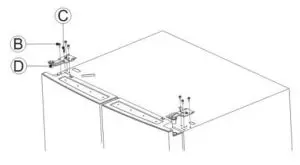
- Use your both hands to open the door more than 90°. Lift it up and take it off.
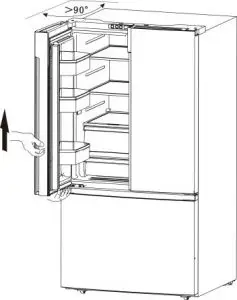
- Remove the 4 hex head bolts hinges (E) with an Allen wrench (4 mm).Remove the lower left and right door hinges (F).
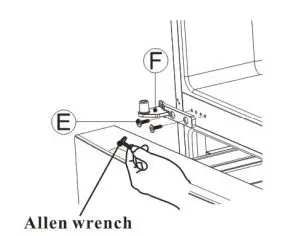
Re-attaching the fridge doors
To reattach the fridge doors after you have moved the appliance to its final location, assemble the parts in reverse order.
- To prevent water leaks, the water line should be fully inserted into the center of the coupler until the guidelines are coincided exactly with the head of the movable part.
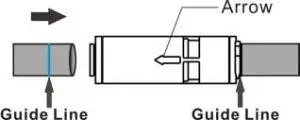
Note:
Arrow on the water line coupler should point to the direction of the door.
2. Make sure the clips are properly connected to the coupler.
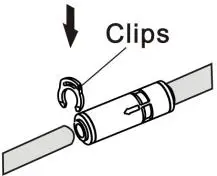
Caution!
In case the fridge doors can’t be self-closed, please make sure the door opened more than 90° when you remove or re-attaching the fridge doors.
Disassembling the freezer door
- Pull out the freezer door and the upper freezer drawer (A) to the final position. Then take out the ice box (B) by lifting it up in the direction of the arrow.
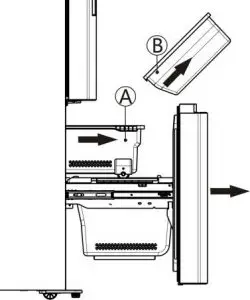
- Take out the upper freezer drawer (A) by lifting it up from the rail system.
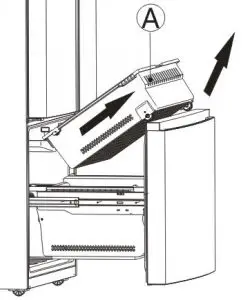
- Remove the lower freezer drawer (C) by lifting it up.
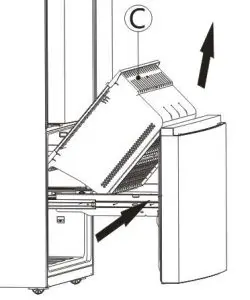
- Remove the 4 screws attached to the supporting frame (D).

- Pull out the freezer door and lift it up in the direction of arrow.
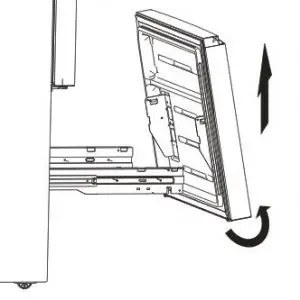
Re-assembling the freezer door
To reattach the drawer after you moved the appliance to its final location, assemble the parts in reverse order.
Installing the water lines and filter (Only applicable for models with ice maker)
A water dispenser with a filter is one of the helpful features on your new appliance. To help promote better health, the water filter removes unwanted particles from your water. However, it does not sterilize or destroy microorganisms. You may need to purchase a water purifying system to do that.
In order for the ice maker to operate properly, a water line is required.
- The maximum inlet water pressure is 689KPa;
- The minimum inlet water pressure is 207KPa.
Warning:
- The water connection must be made by a qualified plumber. Operation outside the water pressure range may cause malfunction, severe and damaging water leaks.
- Under normal conditions, a 200cc (5.75 oz.) cup can be filled in about 10 seconds.
- If the refrigerator is installed in an area with low water pressure (below 30 psi), you can install a booster pump to compensate for the low pressure.
Connecting the water supply
You will need the following tools and parts (not included):
You need to purchase several items to complete this connection. You may find these items sold as a kit at your local hardware store.
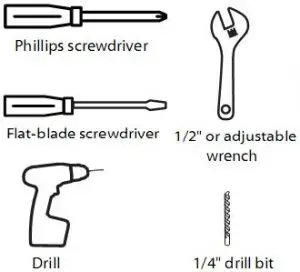
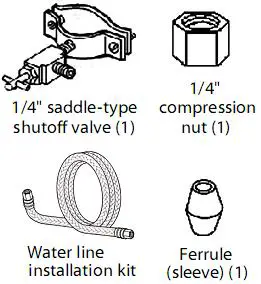
CAUTIONS: Make sure that you: .
- Use the tubing that came with your refrigerator and the water supply installation kit. Do not use old tubing.
- Connect to the cold water pipe. If you connect to the hot water pipe, the purifier may malfunction.
- Connect with the drinkable water only.
- Do not contaminate the water pipes during installation.
- Shut off the main water supply.
- Using a 1/4″ drill bit, drill a hole into the cold water line, then install the saddle-type shutoff valve.
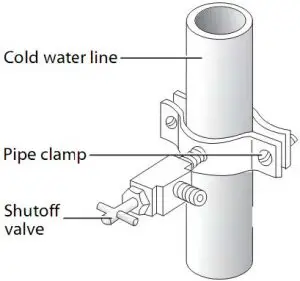
- Connect the water line installation kit (not not included) to the shuincluded) to the shu included) to the shutoff valve.
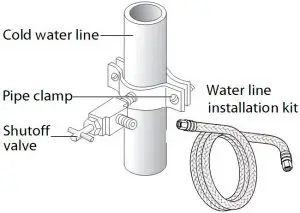
- Turn the main water supply back on, then turn on the shutoff valve and flush out the tubing until the water runs clear. Note: The initial dark discoloration of water is normal.
- Turn off the shutoff valve.
Connecting the water supply to filter inlet
You need to purchase several items to complete this connection. You may find these items sold as a kit at your local hardware store. You can use plastic tubing, copper tubing, or stainless steel tubing as the water line installation kit.
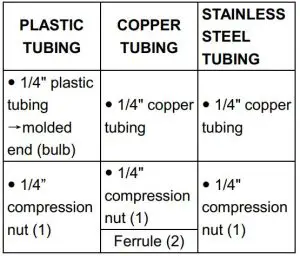
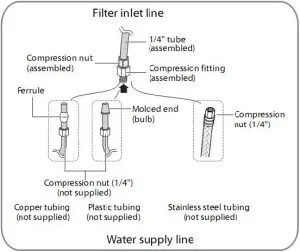
- Connect the water supply line to the compression fitting (assembled with a 1/4″ tube, included in refrigerator).
- If you are using copper tubing, slip the compression nut (not supplied) and ferrule (not supplied) on the copper tubing (not supplied).
- If you are using plastic tubing, insert the molded end (bulb) of the plastic tubing into the compression fitting. Important: Do not use without the molded end (bulb) of the plastic tubing.
- If you are using stainless steel tubing, slip the compression nut on the copper tubing (not supplied).
2. Tighten the compression nut onto the compression fitting. Do not over-tighten the compression nut.
3. Connecting the 1/4″ tube (assembled with compression nut and compression fitting) to water filter inlet, following these steps below.
- Take two clips out, then pull out two stoppers of the water filter.
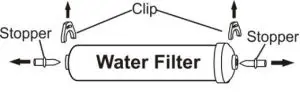
- Fully insert the 1/4″ tube into the inlet of the water filter.
- Insert a clip in the proper position as the figure shown below and confirm that the clip holds the 1/4″ tube firmly.
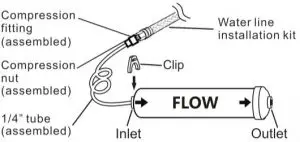
Connecting the water filter outlet to refrigerator
A connector, two clips and a water line (1/4″) are with refrigeratorrefrigerator refrigerator for installation.

- Fully insert one head of the water line water line water line water line water line water line water line (1/4″) into the outlet of water filter.
- Insert a clip in the proper position as the figure shown below and confirm that the clip holds the water line (1/4″) firmly.
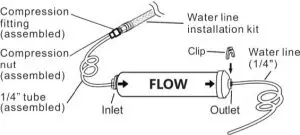
Note:
- In order to fix the water filter at the proper position and avoid over bending the water line (1/4″), you should determine the distance from the shutoff valve to the filter mounting location previously. Then cut the water line (1/4″) as required length.
3. After connecting the water line (1/4″), please turn on the shutoff valve to flush the filter for 5 minutes before use.
Note:
- The initial dark discoloration of water is normal.
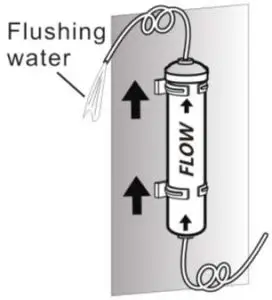
4. Connect the water line (1/4″) with refrigerator by a connector.
- Fully insert the other head of the water line (1/4″) into the connector.
- Fully insert the water line of the water line of the refrigerator refrigerator refrigerator refrigerator (at the right of the compressor room) into the connector.
- Insert two clips in the install pack as shown below, and then confirm that each clip holds the water line firmly.
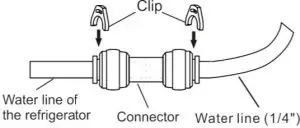
Note:
- The water line must be fully inserted into the center of the connector to prevent water leaking.
Fixing the water filter
To fix the water filter, follow these steps below.
- Determine the location to mount the water filter.
Note:
• The water filter should be mounted on the wall where it is convenient to be replaced.
• Do not mount the filter onto the refrigerator! Coolant pipes might be pierced! - Determine the distance from the shutoff valvevalve to the filter mounting location, and the distance from the filter mounting location to the refrigerator.
- To avoid over bending the water line, cut the water line (1/4″) as required length according to the determined distance previously.
- Mount the filter holder onto the wall by using a screwdriver and attach the water filter.
Warning!
- The water filter must be held upright as shown in the figure. It is critical to connect the water line tube into the filter inlet and outlet correctly.
- The water line (1/4″) length should be less than 5m. If the water line is too long (>5m), the ice and cold water content may be affected due to insufficient water pressure.
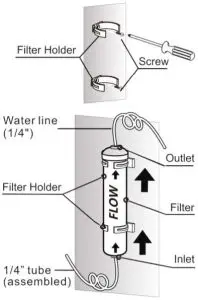
5. After connecting the water supply, water filter, and the refrigerator, water connecting system layout shows below.
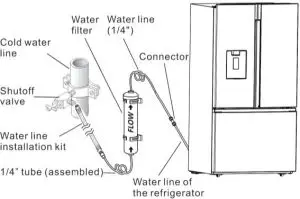
Note:
- It is recommended to employ a qualified person to install the water system.
- If you have to repair or disassemble the water line, cut off the ends of water line (1/4″) to make sure you get a snug, leak-free connection.
Warning!
- After turning on the shutoff valve, make sure that there is no leakage at all connection points of the water lines. If there is a leakage, turn off the shutoff valve immediately and tighten the connector or make the water lines fully inserted into the connector.
- Flush one gallon of water (approximately five minutes) through the filter before drinking or using the water from your refrigerator. –To flush, press a large glass or cup against the water dispenser lever. Fill the glass, then empty it into the kitchen sink. –Repeat until you dispense about one gallon of water.
- The first time you use the water dispenser, you may hear the sound of water pushing air out of the water dispenser. This is normal.
- After powering on the refrigerator, let the ice maker make ice for one to two days, then throw out the first one or two buckets of ice to make sure that all impurities have been removed from the water lines.
- Do not pull hard on the water lines, it may damage the water system.
- The water line should not be pressed by heavy things and should not bend too much
Description of the Appliance
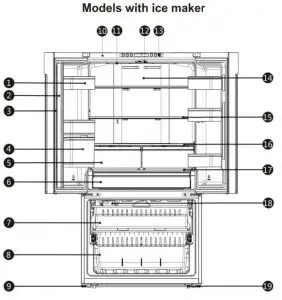
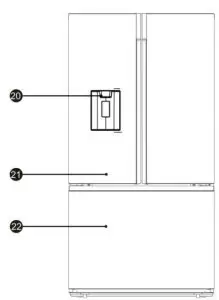
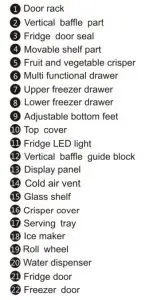
Note!
- Due to unceasing modification of our products, your refrigerator may be slightly different from this instruction manual, but its functions and using methods remain the same.
- To get the best energy efficiency of this product, please place all shelves, drawers and baskets on their original position as per the illustration above.
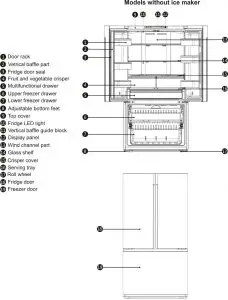
Note!
- Due to unceasing modification of our products, your refrigerator may be slightly different
from this instruction manual, but its functions and using methods remain the same. - To get the best energy efficiency of this product, please place all shelves, drawers and
baskets on their original position as the illustration above.
Display Controls
Your product has one control panel which is installed on the top cover, it may be different
depending on the model. Use your appliance according to the following control guidelines.
Models with ice maker.

Models without ice maker

When the appliance is powered on for the first time, the backlighting of the icons on the display panel will light up immediately. If no buttons have been touched or the doors are closed, the backlighting will turn off after 60seconds.
The control panel consists of two areas about temperature, and one area about different modes.
Caution!
When you set a temperature, you set an average temperature for the whole refrigerator cabinet. Temperatures inside each compartment may vary from the temperatures displayed on the panel, depending on how much food you store and where you place it. High or low room temperature may also affect the actual temperature inside the appliance.
Ice Control (Only applicable for models with ice maker)
 This button controls the ice maker. You can touch the “Ice On/Off” button to control the ice maker. When the “Ice On/Off” function light is on, the ice maker is working. If you want to lock the ice maker, please touch the “Ice On/Off” button again until the button light is off.
This button controls the ice maker. You can touch the “Ice On/Off” button to control the ice maker. When the “Ice On/Off” function light is on, the ice maker is working. If you want to lock the ice maker, please touch the “Ice On/Off” button again until the button light is off.
Fridge Temperature Control
![]() Press the Fridge button to turn on the refrigerator temperature control, then press and hold the Fridge button to select a temperature setting. If you have set the temperature type to Fahrenheit, the temperature settings cycle from 47°F to 35°F in one degree increments.
Press the Fridge button to turn on the refrigerator temperature control, then press and hold the Fridge button to select a temperature setting. If you have set the temperature type to Fahrenheit, the temperature settings cycle from 47°F to 35°F in one degree increments.

If you have set the temperature type to Celsius, the temperature settings cycle from 2°C to 8°C in one degree increments.

Super Cool
 If you want to increase the cooling accelerator to cool products in Fridge, please touch this button. The super cool icon “
If you want to increase the cooling accelerator to cool products in Fridge, please touch this button. The super cool icon “ ![]() ” will be illuminated, and the fridge temperature setting displays at 35°F. Super cool automatically switches off after 3 hours, and the refrigerator temperature setting will revert back to the previous setting.
” will be illuminated, and the fridge temperature setting displays at 35°F. Super cool automatically switches off after 3 hours, and the refrigerator temperature setting will revert back to the previous setting.
When super cool function is on, you can touch the “Super Cool” button again to switch it off. The fridge will not retain the Super Cool function when powered off.
Freezer Temperature Control
 Press the Freezer button to turn on the freezer temperature control, then press and hold the Freezer button to select a temperature setting. If you have set the temperature type to Fahrenheit, the temperature settings cycle from 6°F to -12°F in one degree increments.
Press the Freezer button to turn on the freezer temperature control, then press and hold the Freezer button to select a temperature setting. If you have set the temperature type to Fahrenheit, the temperature settings cycle from 6°F to -12°F in one degree increments.

If you have set the temperature type to Celsius, the temperature settings cycle from -14°C and -24°C in one degree increments.

Super Freeze
 If you want to increase the freezing accelerator in Freezer, please touch this button, the super freeze icon “
If you want to increase the freezing accelerator in Freezer, please touch this button, the super freeze icon “ ![]() ” will be illuminated, the fridge temperature setting displays -12℉.
” will be illuminated, the fridge temperature setting displays -12℉.
Super Freeze can quickly lower the temperature and freeze your food faster than usual. This can retain more of the vitamins and nutrients in fresh food and keep your food longer.
The super freeze mode allows you to freeze items inside with maximum speed. We recommend that you let the appliance operate for 6 hours first. Super Freeze automatically switches off after 52 hours, and the freezer temperature setting will revert back to the previous setting.
When the Super Freeze function is on, you can touch the “Super Freeze”button again to switch off. If power cutoff happens while super freeze is activated, the super freeze will not be reactivated after power resupplied.
Note:
- If you want to exchange the “℉” to “℃”, please press and hold the “Super Cool” and “Energy Saving” buttons for 3 seconds.
Water Filter (Only applicable for models with ice maker)
 In general, you should change the water filter every 6 months to ensure the highest possible water quality. After the refrigerator has dispensed about 300 gallons of water, the filter icon will blink, reminding you to replace the water filter.
In general, you should change the water filter every 6 months to ensure the highest possible water quality. After the refrigerator has dispensed about 300 gallons of water, the filter icon will blink, reminding you to replace the water filter.
First of all, you need to purchase a new water filer. You can purchase the new filter through the Hisense after-sales service system. Before that, please check that the new filter is the same filter type that came with your fridge and can be correctly used in your refrigerator.
After you change a new water filter, push and hold the “Ice On/Off” and “Super Freeze” buttons for 3 seconds to make the blinking stop. When you replace the water filter, some water may leak from the filter and lines. Please let the water flow in a pan and wipe up any leakage that may have occurred.
Energy Saving
 You can touch this button to turn Energy Saving mode on and off. When you turn Energy Saving on, the Energy Saving icon “
You can touch this button to turn Energy Saving mode on and off. When you turn Energy Saving on, the Energy Saving icon “ ![]() ” lights up.
” lights up.
The temperature of the fridge is automatically switched to 42℉ and the freezer to 2℉. If Energy Saving is off, the icon “ ![]() ” will go off and the temperature setting will revert back to the previous setting.
” will go off and the temperature setting will revert back to the previous setting.
Note:
- The control panel will light up when the fridge door is open, or you touch any button.
- The light will go off without touching any buttons or the doors have been closed over one minute.
- When the refrigerator is powered on, all the icons of the control panel will light up for 3 seconds, and a buzzer sounds. And the temperature setting reverts back to the previous setting.
Power on/off (Only applicable for models without ice maker)
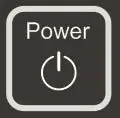 You can switch on or switch off your appliance by pressing this button.
You can switch on or switch off your appliance by pressing this button.
Alarm
- When fridge or freezer door has been opened for over 2 minutes, door alarm will sound. In case of door alarm, buzzer will sound 3 times every 1 minute and will stop alarming automatically after 8 minutes.
- To save energy, please avoid keeping the door open for a long time when using the appliance. The door alarm can also be cleared by closing the door.
Using your Appliance
This section tells you how to use most of the useful features. We recommend that you read through them carefully before using the appliance. It may be different depending on the model
- Using your refrigerator compartment The refrigerator compartment is suitable for storage of vegetables and fruit. Food inside should be packed to store in order to avoid losing moisture or flavor permeating into other foods.
Caution!
Never close the refrigerator door while the shelves, crisper and/or telescopic slides are extended. It may damage both them and the refrigerator.
Glass shelves and Door racks
The refrigerator compartment is provided with several glass shelves and several different door racks, which are suitable for the storage of eggs, canned liquid, bottled drinks and packed food. They can be placed a different heights according to your need. But do not place too many heavy things in racks. Before you lift up the door shelf vertically, please take the food out.

Note:
All the door racks and shelves can be taken out to be cleaned. When you remove the shelves, gently pull them forward until the shelf comes clear of the shelf guides.
When you return the shelves, make sure there is no obstacle behind and gently push the shelf back into the position.
Drawers
These are suitable for storage of fruits and vegetables. And it can be taken out to be cleaned.
To take them out, open the door to the final location first. Then pull out the drawer and tilt up the front of the crisper after moving slightly in the direction.
2. Using the dispenser to get cold water (Only applicable for models with water dispenser)
The water dispenser is located on the left fridge door. Move your cup down the dispenser lever in the suggested position and press it.
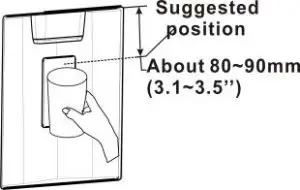
Note:
- Don’t push the dispenser lever forward without cup, it may cause the water leak from the dispenser.
- Do not immediately removing your cup or glass from the dispenser after dispensing water you need. You should wait for 2 or 3 seconds to prevent spills.
- Do not pull the lever out, it could damage or break the lever’s spring.
- Dispenser does not work when door is not closed.
- Take water frequently or largely or you first use this function, the water may not cold enough. Please wait for some time to ensure the appropriate temperature.
Water clouding phenomenon
All water provided to the refrigerator flows through the filter which is an alkaline water filter. In the filtering process, the pressure of the water that has flowed out of the filter is increased, and the water becomes saturated with oxygen and nitrogen. When this water flows out into the air, the pressure plummets and the oxygen and nitrogen get supersaturated, which results in gas bubbles. The water may temporarily look misty or cloudy due to these oxygen bubbles. After a few seconds, the water will look clear.
3. Using the freezer compartment
The freezer compartment is provided with an upper drawer, a lower drawer and a ice box (optional). To remove all of them, refer to page 7 for disassembly instruction.
Automatic Icemaker (Only applicable for models with ice maker)
Automatic Ice maker can make ice automatic。
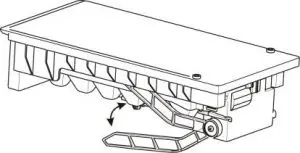
Note:
- When the ice maker dumps ice into the ice box, any sounds you hear are part of normal operation.
- If you do not dispense ice for a long periods of time, Ice may clump in the Ice box. If this occurs, please remove all the ice and empty the box
- If you are going on a long vacation or business trip and won’t be using the water dispenser or ice maker part for period of time, please close the water supply to prevent leaks.
- The ice made by the ice maker first batches cannot be used for eating or drinking cause it is unhealthiness.
- Cannot store liquid cans in ice box, it may cause burst.
Warning!
Do not allow your children to hang off the dispenser or touch the ice maker. This could cause injury.
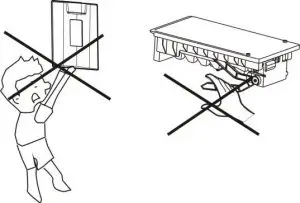
Cleaning and care
For hygienic reasons the appliance (including exterior and interior accessories) should be cleaned regularly at least every two months.
Caution!
The appliance must not be connected to the mains during cleaning. Danger of electrical shock! Before cleaning switch the appliance off and remove the plug from the mains socket.
Exterior cleaning
To maintain good appearance of your appliance, you should clean it regularly.
- Spray water onto the cleaning cloth instead of spraying directly on the surface of the appliance. This helps ensure an even distribution of moisture to the surface.
- Clean the doors, handles and cabinet surfaces with a mild detergent and then wiped dry with a soft cloth.
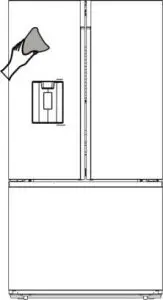
Caution!
- Don’t use sharp objects as they are likely to scratch the surface.
- Don’t use Thinner, Car detergent, Clorox, ethereal oil, abrasive cleansers or organic solvent such as Benzene for cleaning. They may damage the surface of the appliance and may cause fire.
Interior cleaning
You should clean the appliance interior regularly. It will be easier to clean when food stocks are low. Wipe the inside of the fridge freezer with a weak solution of bicarbonate of soda, and then rinse with warm water using a wrung-out sponge or cloth. Wipe completely dry before
replacing the shelves and baskets. Thoroughly dry all surfaces and removable parts before putting them back into place.
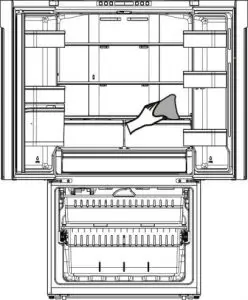
Although this appliance automatically defrosts, a layer of frost may occur on the freezer compartment’s interior walls if the freezer door is opened frequently or kept open too long. If the frost is too thick, choose a time when the freezer is nearly empty and proceed as follow:
- Remove existing food and accessories baskets, unplug the appliance from the mains power and leave the doors open. Ventilate the room thoroughly to accelerate the process.
- When defrosting is completed, clean your freezer as described above.
Warning!
Do not use sharp objects to remove frost from the freezer compartment. Only after the interior is completely dry should the appliance be switched back on and plugged back into the mains socket.
Door seals cleaning
Take care to keep door seals clean. Sticky food and drinks can cause seals to stick to the cabinet and tear when you open the door. Wash seal with a mild detergent and warm water. Rinse and dry it thoroughly after cleaning.
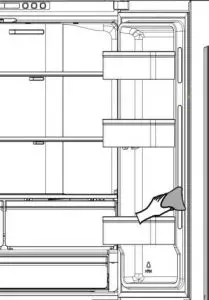
Caution!
Only after the door seals are completely dry should the appliance be powered on.
Replacing the LED light
Warning: The LED light must be replaced by a competent person. If the LED light is damaged, follow the steps below:
- Unplug the refrigerator from the electrical outlet.
- Locate the LED light on the inside of the refrigerator.
- Remove the light cover. Insert a tool (tweezers or a screwdriver) along the side opening of the LED light cover. Pop open the side over the cover, grasp the exposed side and gently pull towards you to remove the item and expose the LED light.
- Replace the new LED light.
- Replace the light cover.
Helpful hints and tips
Energy saving tips
We recommend that you follow the tips below to save energy.
- Try to avoid keeping the door open for long periods in order to conserve energy. Ensure the appliance is away from any sources of heat (Direct sunlight, electric oven or cooker etc.)
- Don‘t set the temperature colder than necessary.
- Don’t store warm food or evaporating liquid in the appliance.
- Place the appliance in a well ventilated, humidity free, room. Please refer to Installing your new appliance chapter.
- If the diagram shows the correct combination for the drawers, crisper and shelves, do not adjust the combination as this is designed to be the most energy efficient configuration.
Hints for fresh food refrigeration
- Do not place hot food directly into the refrigerator or freezer, the internal temperature will increase resulting in the compressor having to work harder and will consume more energy.
- Do cover or wrap the food,particularly if it has a strong flavor.
- Place food properly so that air can circulate freely around it.
Hints for refrigeration
- Meat (All Types) Wrap in polythene food: wrap and place on the glass shelf above the vegetable drawer. Always follow food storage times and use by dates suggested by manufacturers.
- Cooked food, cold dishes, etc.: They should be covered and may be placed on any shelf.
- Fruit and vegetables:
They should be stored in the special drawer provided. - Butter and cheese:
Should be wrapped in airtight foil or plastic film wrap. - Milk bottles:
Should have a lid and be stored in the door racks.
Hints for freezing
- When first starting-up or after a period out of use, let the appliance run at least 2 hours on the higher settings before putting food in the compartment.
- Prepare food in small portions to enable it to be rapidly and completely frozen and to make it possible to subsequently thaw only the quantity required.
- Wrap up the food in aluminum foil or polyethylene food wraps which are airtight,
- Do not allow fresh,unfrozen food to touch the food which is already frozen to avoid temperature rise of the latter.
- Iced products,if consumed immediately after removal from the freezer compartment, will probably cause frost burns to the skin.
- It is recommended to label and date each frozen package in order to keep track of the storage time.
Hints for the storage of frozen food
- Ensure that frozen food has been stored correctly by the food retailer
- Once defrosted , food will deteriorate rapidly and should not be re-frozen. Do not exceed the storage period indicated by the food manufacturer.
Switching off your appliance
If the appliance needs to be switched off for an extended period, the following steps should be taken prevent mould on the appliance.
- Remove all food.
- Remove the power plug from the mains socket.
- Clean and dry the interior thoroughly.
- Ensure that all the doors are wedged open slightly to allow air to circulate.
Troubleshooting
If you experience a problem with your appliance or are concerned that the appliance is not functioning correctly, you can carry out some easy checks before calling for service, please see below.
Warning! Don’t try to repair the appliance yourself. If the problem persists after you have made the checks mentioned below, contact a qualified electrician, authorized service engineer or the shop where you purchased the product.
Warning! A child entrapment warning statement is included in either the operating
instructions or in a use and care manual provided with each refrigerator.
DANGER: Risk of child entrapment. Before you throw away your old refrigerator or freezer:
- Take off the doors.
- Leave the shelves in place so that children may not easily climb inside.
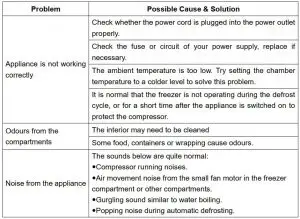
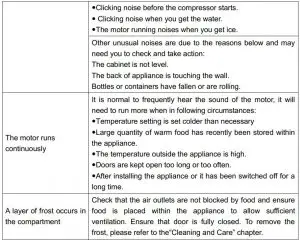
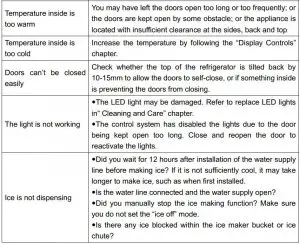
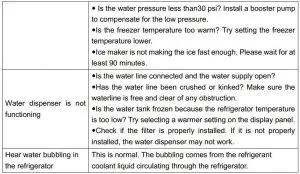
Disposal of the Appliance
It is prohibited to dispose of this appliance as household waste.
Packaging materials
Packaging materials with the recycle symbol are recyclable. Dispose of the packaging into
a suitable waste collection container to recycle it.
Before disposal of the appliance
1. Pull out the main plug from the main socket.
2. Cut off the power cord and discard with the main plug
Warning!
Refrigerators contain refrigerant and gases in the insulation. Refrigerant and gases must be disposed of professionally as they may cause eye injuries or ignition. Ensure that tubing of the refrigerant circuit is not damaged prior to proper disposal.
Correct Disposal of this product
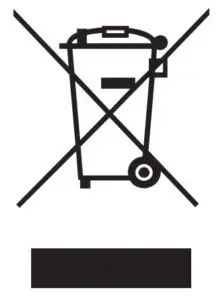 This symbol on the product or in its packing indicates that this product may not be treated as household waste. Instead, it should be taken to the appropriate waste collection point for the recycling of electrical and electronic equipment. By ensuring this product is disposed of correctly, you will help prevent potential negative consequences for the environment and human health, which could otherwise be caused by the inappropriate waste handling of this product. For more detailed information about the recycling of this product, please contact your local council, your household waste disposal
This symbol on the product or in its packing indicates that this product may not be treated as household waste. Instead, it should be taken to the appropriate waste collection point for the recycling of electrical and electronic equipment. By ensuring this product is disposed of correctly, you will help prevent potential negative consequences for the environment and human health, which could otherwise be caused by the inappropriate waste handling of this product. For more detailed information about the recycling of this product, please contact your local council, your household waste disposal
service, or the shop where you purchased the product.
